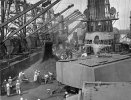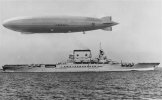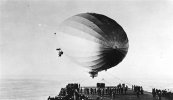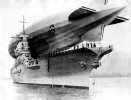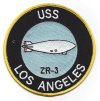-
Please take a moment and update your account profile. If you have an updated account profile with basic information on why you are on Air Warriors it will help other people respond to your posts. How do you update your profile you ask?
Go here:
Edit Account Details and Profile
You are using an out of date browser. It may not display this or other websites correctly.
You should upgrade or use an alternative browser.
You should upgrade or use an alternative browser.
Ship Photo of the Day
- Thread starter Randy Daytona
- Start date
Nelson never fought the Americans!Bow and stern "Chasers", forward and rearward firing large guns, were used for long range shots. On a side note, one of Nelson's combat dictates was long range shots were a waste, and fighting yard arm to yard arm was much more effective.
The French equivalent of the Iowa class would have been the Alsaces class. Although there were 3 different design concepts, the last and largest mounting 3 quadruple turrets with 15” rifles would have been most likely. With nearly the same speed, a little more armor and better torpedo defense, these would have been formidable warships.
In keeping with most European designs, there was a separate and dedicated anti-ship 6” secondaries and 100mm anti-aircraft guns. Interesting how the French were able to mount more guns on the centerline, and what improvements could have been made with the Iowas for more centerline weapons.
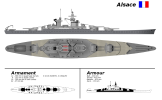
In keeping with most European designs, there was a separate and dedicated anti-ship 6” secondaries and 100mm anti-aircraft guns. Interesting how the French were able to mount more guns on the centerline, and what improvements could have been made with the Iowas for more centerline weapons.

SMS Markgraf was 1 of 4 Konig class dreadnoughts of the Imperial German Navy. It fought in most of the major naval engagements of WW1, suffering multiple large caliber hits at Jutland.
Interned at Scapa Flow after the war, she was scuttled by her crew on 21 June 1919 along with 14 other battleships of the High Seas Fleet. Panicked and/or infuriated British sailors watching their prizes sink shot Captain Walter Schumann and 9 other German sailors in a lifeboat, the last casualties of WW1.
Length: 575 ft, Beam: 96 ft, Draft. 30 ft
Displacement: 28,100 tons
3 oil fired boilers and 12 coal fired boilers gave 45,500 horsepower through 3 screws resulting in 21 knots
Armament: 10 (5x2) 12” S/K L50 Krupp cannons firing 915 lb shells
14 ((14x1) 5.9” cannons.
Armor: main belt of up to 13.8”

 www.historynet.com
www.historynet.com
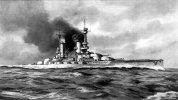
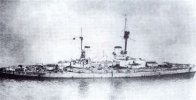
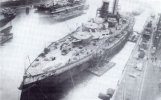
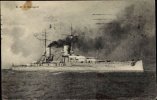
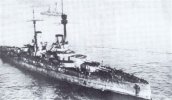
Interned at Scapa Flow after the war, she was scuttled by her crew on 21 June 1919 along with 14 other battleships of the High Seas Fleet. Panicked and/or infuriated British sailors watching their prizes sink shot Captain Walter Schumann and 9 other German sailors in a lifeboat, the last casualties of WW1.
Length: 575 ft, Beam: 96 ft, Draft. 30 ft
Displacement: 28,100 tons
3 oil fired boilers and 12 coal fired boilers gave 45,500 horsepower through 3 screws resulting in 21 knots
Armament: 10 (5x2) 12” S/K L50 Krupp cannons firing 915 lb shells
14 ((14x1) 5.9” cannons.
Armor: main belt of up to 13.8”

Parting Shot at Scapa Flow: Firing the Final Salvo of World War I
In June 1919, seven months after the signing of the armistice, a determined admiral of the Imperial German Navy fired the final salvo of World War I





Last edited:
USS England DE-365 was a small Buckley class destroyer escort. Measuring 306 ft long and a full load of 1,700 tons, the England only mounted 3 single 3”/50 cal guns and 3 torpedo tubes; however she was equipped with depth charges and hedgehog anti-submarine charges (the latter explode upon contact, not a preset depth).
With these anti-submarine weapons, the England sank not 1, not 2, but 6 Japanese submarines in a 12 day span from 19 May 1944 to 31 May 1944 - a record unmatched in naval history.

 nationalinterest.org
nationalinterest.org
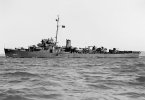
USS England off San Francisco, 9 February 1944
With these anti-submarine weapons, the England sank not 1, not 2, but 6 Japanese submarines in a 12 day span from 19 May 1944 to 31 May 1944 - a record unmatched in naval history.

Meet The USS England: The Warship That Sent The Most Submarines To The Ocean Floor
Here’s What You Need To Remember: For almost 73 years, the USS England has set a record for most subs sunk by a single ship. That record remains unbroken. Destroyer escorts were the econo-warships of the U.S. Navy in World War II. Designed to be smaller and cheaper alternatives to Navy...

USS England off San Francisco, 9 February 1944
USS Strong DD-467 was a Fletcher class destroyer that served in the Pacific during WW2. It has the unfortunate distinction of sinking after the longest fatal torpedo strike known, 11 miles, when it was hit on 5 July 1943 by a salvo from the destroyer IJN Niizuki.
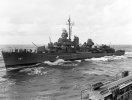
USS Strong highlines mail to USS Honolulu during operations in the Solomon Islands area, c. early July 1943


USS Strong highlines mail to USS Honolulu during operations in the Solomon Islands area, c. early July 1943

USS Barb SS-220 was a Gato class sub that not only sank the 3rd most tonnage (17 ships, 96,000+ tons) of any US warship in WW2, it actually put ashore a landing party in Japan that blew up a train. Lieutenant Commander Eugene “Lucky” Fluckey won the CMH and would ultimately retire as a Rear Admiral.
Great story below:

 www.historynet.com
www.historynet.com
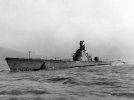
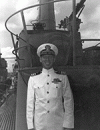
Great story below:

Hell and High Water: The USS Barb
Eugene Fluckey threw out the operating manual to become one of the deadliest American submarine commanders in the Pacific during World War II. His sub USS Barb sank ships, shelled factories and even blew up a train.


What the name “Enterprise” means to the USN, the Royal Navy equivalent would have to be “Warspite”, (Pennant #03) the “ Grand Old Lady” of the Fleet. A Queen Elizabeth class battleship of 644 ft and 34,000 tons mounting eight 15” cannons and laid down on Halloween 1912, she had a reputation for unparalleled toughness - to use a boxing metaphor, the Randall Tex Cobb of dreadnoughts and won more battle honors (15) than any ship in the long and distinguished history of the Royal Navy.
At Jutland, she was part of the 5th Battle Squadron. An early hit to her steering led her to make 2 complete circles in front of the Kaiser’s High Seas fleet, taking 15 major caliber hits - to which Warspite seemed to reply, “What else have you got?”
As WW2 started, she led a force to Narvik, Norway to attack and sink an entire squadron of 8 trapped German destroyers: not content to use just guns, even Warspite’s Swordfish floatplane was in on the action, dropping a 250 lb bomb on U-64 and scoring the first U-Boat sinking of the conflict.
Heading to the Med, she led an attack on 2 Italian battleships at the Battle of Calabria in July 1940, scoring the longest range hit (26,000 yards) on another battleship which crippled the Giulio Cesare. Following up in March 1941, Warspite and her sisters Valiant and Barham drove off the Italian battleship and caught 3 Italian heavy cruisers and 2 destroyers at a point blank range of less than 4,000 yards, annihilating all 5 ships.
On 14 September 1943, she came under attack by Dornier DO-217’s of the Luftwaffe carrying the new Fritz X 3,000 lb radio controlled glidebomb. 2 scored near misses, the third a direct hit that penetrated completely through the center of the ship, blowing a 20 foot hole open in the keel.
Her final actions were supporting the invasion and subsequent campaign at D-Day. During her career, she sank numerous ships, survived a grounding, a mine hit, major caliber gun hits, bomb hits, a guided missile hit and 4 collisions. Incredibly, and unforgivably, the Royal Navy did not save her as a museum ship. Pugnacious to the end, Warspite broke away from the 2 tugs towing her to the scrapyards and grounded herself, forcing the salvage crews to eventually come to her.
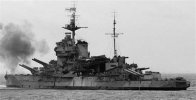
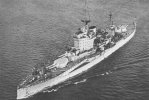
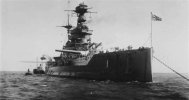
At Jutland, she was part of the 5th Battle Squadron. An early hit to her steering led her to make 2 complete circles in front of the Kaiser’s High Seas fleet, taking 15 major caliber hits - to which Warspite seemed to reply, “What else have you got?”
As WW2 started, she led a force to Narvik, Norway to attack and sink an entire squadron of 8 trapped German destroyers: not content to use just guns, even Warspite’s Swordfish floatplane was in on the action, dropping a 250 lb bomb on U-64 and scoring the first U-Boat sinking of the conflict.
Heading to the Med, she led an attack on 2 Italian battleships at the Battle of Calabria in July 1940, scoring the longest range hit (26,000 yards) on another battleship which crippled the Giulio Cesare. Following up in March 1941, Warspite and her sisters Valiant and Barham drove off the Italian battleship and caught 3 Italian heavy cruisers and 2 destroyers at a point blank range of less than 4,000 yards, annihilating all 5 ships.
On 14 September 1943, she came under attack by Dornier DO-217’s of the Luftwaffe carrying the new Fritz X 3,000 lb radio controlled glidebomb. 2 scored near misses, the third a direct hit that penetrated completely through the center of the ship, blowing a 20 foot hole open in the keel.
Her final actions were supporting the invasion and subsequent campaign at D-Day. During her career, she sank numerous ships, survived a grounding, a mine hit, major caliber gun hits, bomb hits, a guided missile hit and 4 collisions. Incredibly, and unforgivably, the Royal Navy did not save her as a museum ship. Pugnacious to the end, Warspite broke away from the 2 tugs towing her to the scrapyards and grounded herself, forcing the salvage crews to eventually come to her.



Meant to get back to this: the best photo I could find of a 1941 Standard class battleship (USS Arizona) showing the secondary armament along the side: anti-ship 5”/51 cal casement guns + a few single 5”/25 cal anti-aircraft guns compared to the USS Missouri in 1945 with dual purpose 5”/38 cal, quad 40mm Bofors and 20mm Oerlikons. Eventually the 20mm’s went away and the 40mm’s were to be replaced by twin 3”/50 cals firing proximity shells - a deadly gauntlet for the propeller driven aircraft of the period.What’s interesting, when one looks over the last two pages or so of this thread, is the shift from armor, to torpedo belts, and on to AA defense. Were we to look at WWII cruisers under the same light we’d see the shift from gun cruisers to AA cruisers (like the Atlanta class) and on to fully equipped AA cruisers like the the Juneau class.
(Sidenote: the development of the 5”/38 dual purpose between the 5”/51 and 5”/25 is a good story)
With the rapid development of both air and sea drones, I wonder if we see a return of more secondary weapons in the 57mm / 75mm range?
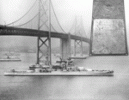
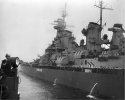
Last edited:
Looks like the first RAST. Bet the cable broke.Some good shots of USS Saratoga (CV-3) with USS Los Angeles (ZR-3)
View attachment 38857
View attachment 38858
View attachment 38859
View attachment 38860
105 years ago (Feb 1918) and here is a photo of the USS New York (BB 34) coaling at sea. The collier just dumps the coal on the battleship's deck and from then on it's back-breaking work to shovel the coal into wheelbarrows and presumably dump the wheelbarrows into chutes leading to the bunkers. And the sailors are in whites. You can imagine that coal dust was everywhere. 